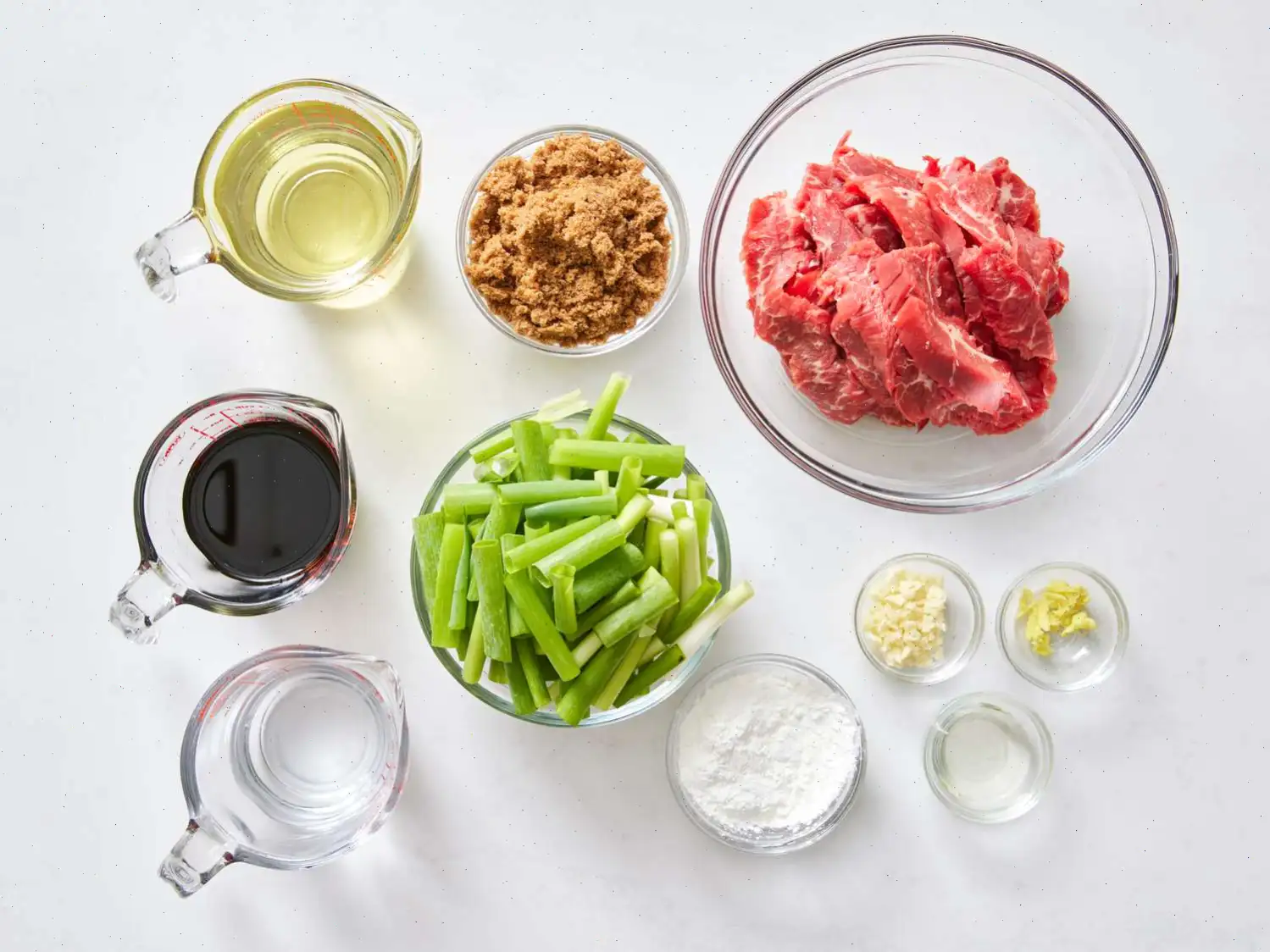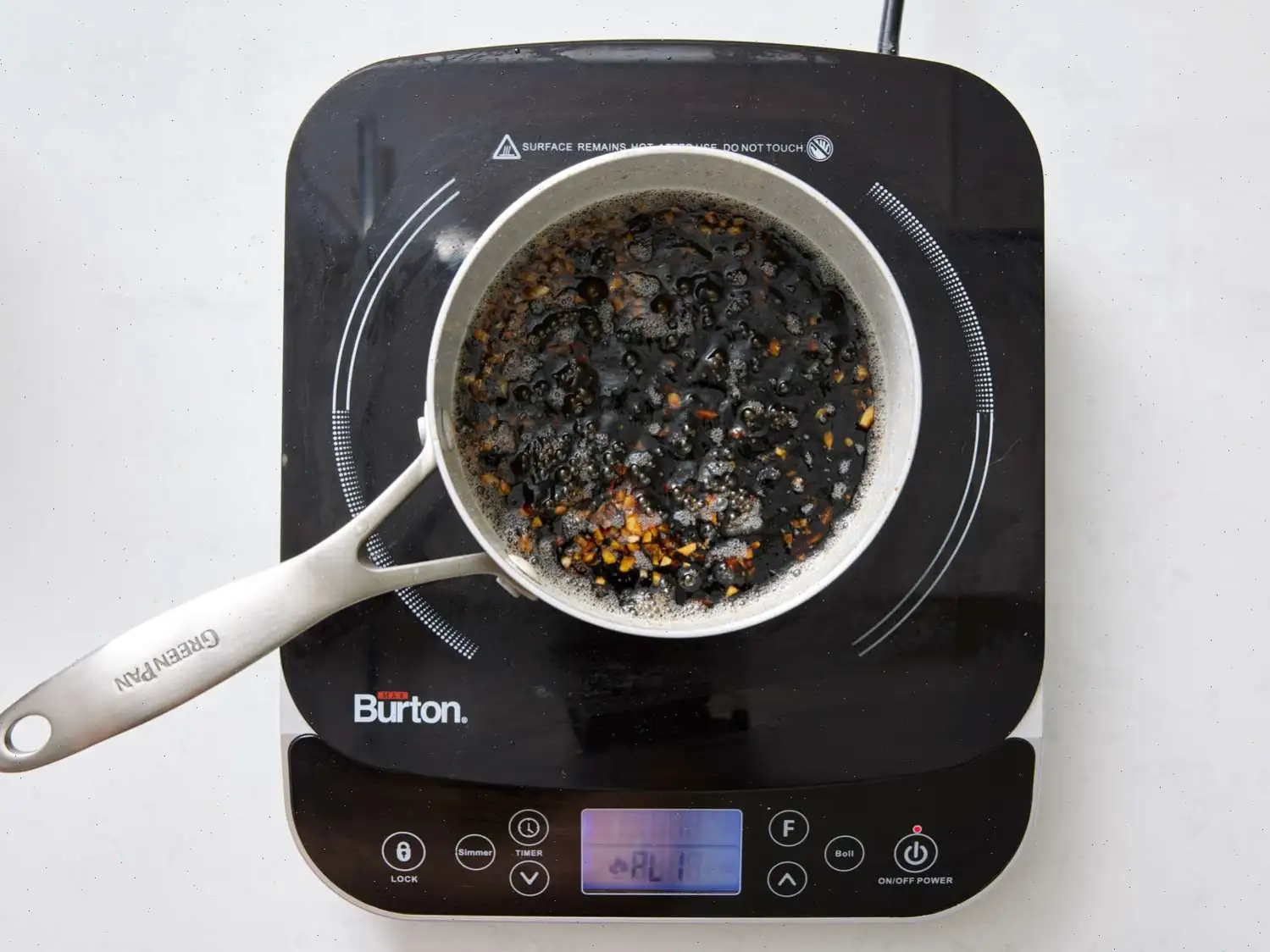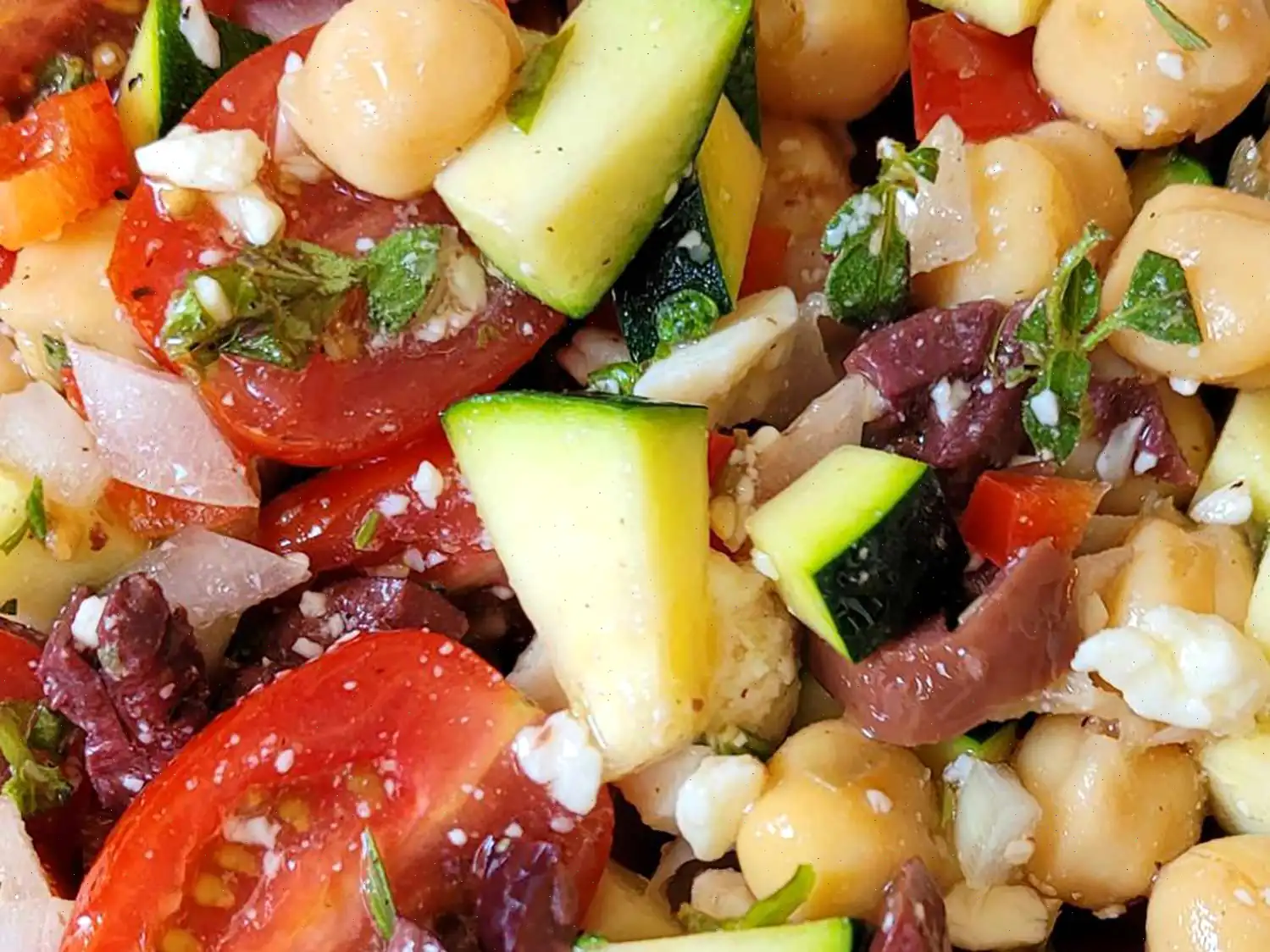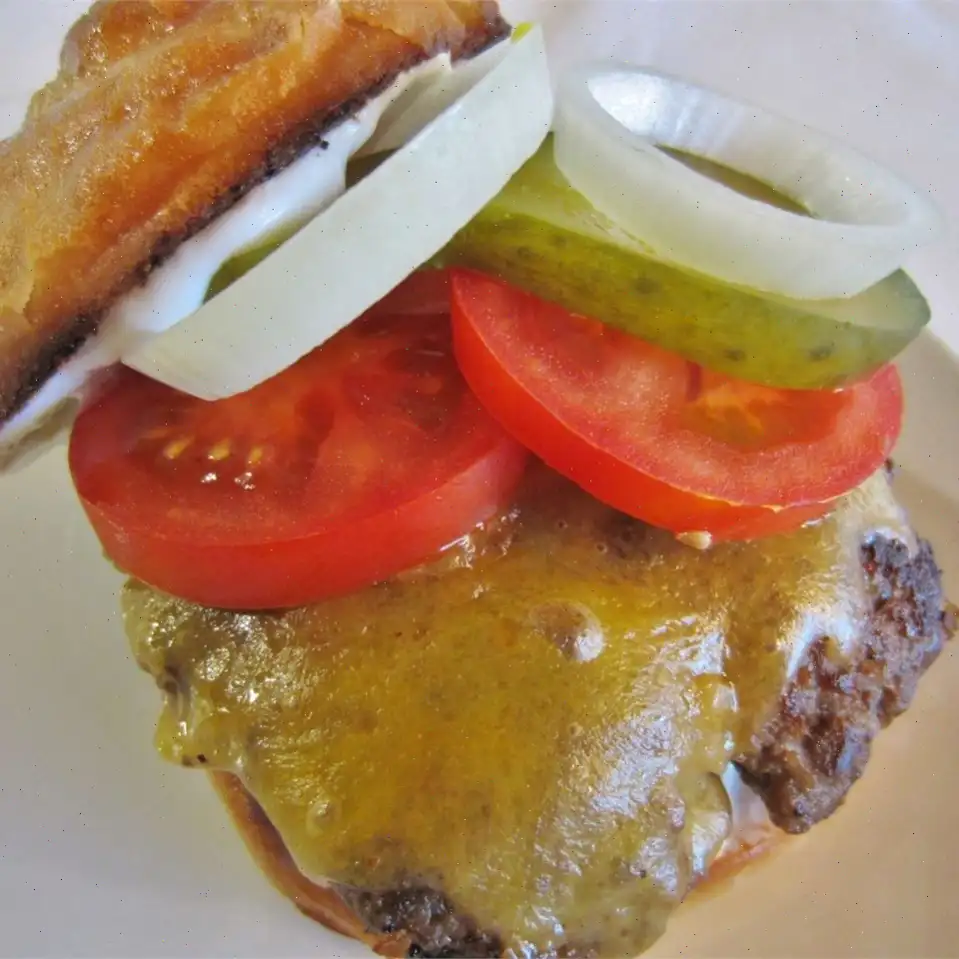
Mongolian Beef and Spring Onions Recipe
Beef with Garlic and Ginger Sauce
Ingredients
- 2 teaspoons vegetable oil
- 1 tablespoon finely chopped garlic
- teaspoon grated fresh ginger root
- cup dark brown sugar
- cup soy sauce
- cup water
- 1 pound beef flank steak, sliced inch thick on the diagonal
- cup cornstarch
- 1 cup vegetable oil for frying
- 2 bunches green onions, cut in 2-inch lengths
Directions
Step 1: Gather all ingredients and have them ready for use.
Step 2: In a saucepan, heat 2 teaspoons of vegetable oil over medium heat. Add the chopped garlic and grated ginger. Stir constantly and cook until fragrant, about 30 seconds.
Step 3: Add dark brown sugar, soy sauce, and water to the saucepan. Stir to combine. Increase the heat to medium-high and bring the sauce to a boil. Let it simmer for about 4 minutes until it slightly thickens. Remove from heat and set aside.
Step 4: Place the sliced beef in a large bowl. Add cornstarch and toss to coat the beef evenly. Let the mixture sit for about 10 minutes, allowing the cornstarch to absorb into the beef.
Step 5: Heat 1 cup of vegetable oil in a deep skillet to 375F (190C). Shake off any excess cornstarch from the beef slices and drop them into the hot oil in batches. Stir gently and fry until the edges are crispy, approximately 2 minutes per batch.
Step 6: Using a large slotted spoon, remove the fried beef slices and drain on paper towels to remove excess oil.
Step 7: Remove most of the oil from the skillet, leaving just a small amount. Heat the skillet over medium heat and add the fried beef slices. Pour in the prepared sauce and stir to coat the beef.
Step 8: Add the chopped green onions to the skillet and bring the mixture to a boil. Cook for about 1-2 minutes, just until the onions have softened and turned bright green.
Step 9: Serve the dish hot and enjoy!
Nutrition Facts (per serving)
| Calories | Fat | Carbs | Protein |
|---|---|---|---|
| 391 | 12g | 55g | 18g |
Percent Daily Value
- Total Fat: 16% (12g)
- Saturated Fat: 14% (3g)
- Cholesterol: 9% (27mg)
- Sodium: 81% (1862mg)
- Total Carbohydrate: 20% (55g)
- Dietary Fiber: 12% (3g)
- Protein: 36% (18g)
- Vitamin C: 24% (22mg)
- Calcium: 10% (130mg)
- Iron: 19% (4mg)
- Potassium: 13% (606mg)
Note: Percent Daily Values are based on a 2,000-calorie diet. Your daily values may be higher or lower depending on your calorie needs.

History of Mongolian Beef
Despite its name, Mongolian Beef does not originate from Mongolia, but rather from Chinese-American cuisine. The dish is thought to have been created in the United States during the 20th century, likely as a way to introduce Chinese flavors to the American palate. Its combination of tender beef, soy sauce, and sweetness is a departure from traditional Mongolian cooking, which typically features hearty stews and mutton. The term "Mongolian" was likely used as a marketing tool, appealing to the exotic allure of Mongolia. Today, Mongolian Beef is a staple of Chinese-American restaurants and has become a favorite among home cooks.
Regional Variations of Mongolian Beef
While the dish is beloved across the globe, its preparation can vary depending on the region. In the U.S., it's commonly served with a sweet soy-based sauce and crispy fried beef. However, in places like Taiwan, the dish may have a more savory and subtle flavor profile, with less emphasis on sugar. Additionally, Mongolian Beef recipes often feature different vegetables, such as bell peppers or carrots, depending on whats available locally. While spring onions are a typical garnish, some versions of the dish may use shallots or leeks for a milder taste.
How Mongolian Beef Differs from Similar Dishes
Mongolian Beef is often compared to other stir-fried beef dishes like Beef with Broccoli or Kung Pao Beef. What sets Mongolian Beef apart is its thick, sweet sauce made from brown sugar, soy sauce, and sometimes hoisin sauce. The beef is coated in cornstarch before being fried, giving it a crispy texture that contrasts with the tender meat. In comparison, dishes like Beef with Broccoli are more savory, with soy sauce and garlic dominating the flavor. Mongolian Beefs focus on sweetness and the crispy coating is what makes it unique in the world of Chinese-American stir-fries.
Where is Mongolian Beef Typically Served?
This dish is most commonly found in Chinese-American restaurants, especially those that specialize in stir-fries. Its also a popular menu item in many family-style eateries where comfort food is a priority. Mongolian Beef is often served alongside steamed rice or noodles, allowing diners to enjoy the rich, savory sauce with every bite. The dish is ideal for a quick weeknight dinner or as a part of a larger Chinese-inspired feast. Youll also find variations of the dish at food courts, especially in the United States and Canada, where it has become a beloved choice for many.
Fun Facts About Mongolian Beef
- Despite its name, Mongolian Beef isnt traditionally found in Mongolia! It is a product of Chinese-American fusion cuisine.
- The dish became a fixture in the U.S. in the 1980s, largely due to the rise of Chinese buffet restaurants.
- While the beef is typically fried for a crispy texture, some people prefer to grill or stir-fry the meat for a healthier version.
- Some variations of the dish include extra spices like red pepper flakes or chili paste, adding a spicy kick to balance out the sweetness of the sauce.
You can listen to this recipe in AI audio format. Simply click the play button below to listen to the content in a format that suits you best. It’s a great way to absorb information on the go!
FAQ about Mongolian Beef and Spring Onions Recipe
Comments
jeff97
10/06/2025 01:52:54 PM
Delicious!! But way too sweet. What I did the second time was to simply add tablespoons of the brown sugar until I found the right balance between the sweet and salty. Two tablespoons were enough for me.
Dogg
05/22/2024 02:54:30 PM
This was good good good. Three goods worth. I also slightly lowered the sugar amount (another reviewer suggested this). I don't need those extra cals, you dig? Delicioso flavors throughout this dish. My favorite part was the spring onions. I love a fresh spring onion. Also, I grilled my meat instead of frying. (remember the calories?) In summation, I give this recipe a 4.5, which I will round up to 5. I felt like a Mongol while eating this, that's how authentic it is.
Jon3960
07/18/2021 01:01:07 PM
This was fantastic! A great flavor slightly sweet and sticky. Just a couple of hints. The first is use a small top round London broil and save yourself a about $3 a pound or more. The second is slice the meat slightly defrosted. Yes, freeze the meat and slice once the knife can cut through the center safely. This will allow thinner more uniform thicknesses of the slices. The third hint is to double the sauce Everyone will want to add the sauce to the rice liberally since it is so good. The only issue was the mess it made frying the meat on my stove but it was well worth it. Enjoy
Jessica Rupe
12/28/2020 09:23:03 PM
Very yummy! Like others, I have also varied the ingredients, using what I had on hand. I used extra virgin olive oil to make the sauce, instead of vegetable or canola oil. I also used 1/4 cup of the brown sugar. I used half low sodium and half regular soy sauce, to cut the salt. I also used unsalted beef stock instead of water, to boost the beefy flavor. I added a small squeeze of Korean gochujang paste to add a touch of heat, and some unseasoned rice vinegar to cut the sweetness in the sauce. The beef I used was already cooked, so I coated it with cornstarch and added it to the sauce, cooking it until the meat was heated through and the sauce was thick. I did not add the spring onions, as the beef I used already had onions in it.
cardiffjen
05/03/2023 05:08:56 AM
Turned out pretty good after I adjusted the sugar and soy sauce as suggested by other reviewers. Used 1/4 cup brown sugar, 1/4 cup soy sauce, and 1/4 cup water. It was too much sauce, so I ended up using only half. I think it would’ve been way too salty otherwise. I also added red peppers and used olive oil instead of vegetable oil.
Rhonda
07/03/2020 12:08:23 AM
We follow the recipe almost exactly except we use low sodium soy, add 1 c. chopped sautéed broccoli and 3 cayenne peppers. One of our family favorites. Never any leftovers.
Chef Daddy
01/03/2021 05:24:13 AM
Tastes great. Even my kids (who love to ridicule my cooking) liked it. Some refinements I suggest: (1) use less brown sugar and maybe even offset the sweetness by adding a little more garlic; (2) cut the green onions into 1 to 1 1/4 inch pieces; (3) add 1 can of bamboo shoots , sautéed with the beef before adding the sauce; (4) add 1/4 to 1/2 tsp of orange zest to the beef and fry with the beef before adding the sauce. For vegetarians: Substitute firm cubed tofu for beef and you will need to add vegetables, such as broccolini or asparagus.
Ashley Marie
07/11/2020 01:00:54 AM
I really loved it! i put in a 1/2 cup of sugar instead of 2/3 because i thought that would be way to much sugar. i had a lot of fun making. i also stir fried it in my wok because i didn’t want to fry it, i was still amazing the rest of my family loved it too!
sdbooker
09/03/2020 09:02:53 PM
Really sweet, needs heat like a couple of dried red peppers for balance. Also you need to add cornstarch to the sauce because the sauce did not thicken. There is no reason to deep fry the meat you can cook it in a pan with a little bit of oil. It doesn’t call for seasoning of the meat but I found that it does need some salt and pepper.While eating it, it was missing a crunch so maybe add an unsalted peanut or carrot or something to give it texture. Add vegetables like red peppers mushrooms etc. for a more balanced meal.If cooked as is, you have runny sweet sauce with tasteless meat.
Donna
06/01/2024 12:07:53 PM
So very glad I read reviews before making. The recipe as written has WAY too much brown sugar. A reviewer recommended 2T vs 2/3cup. I doubled the recipe, but using only 3 1/2 T of brown sugar. It was excellent!
Debby
02/02/2021 02:30:21 AM
This was delicious, the only changes I made was reducing the brown sugar and adding stir fries vegetables to the skillet after I removed the beef and sauce. Served with rice and sprinkled sesame seeds on top with the green onions.
laura108
07/03/2025 09:15:05 PM
This will be going on the menu regularly. I did add hot pepper flakes to mine! Seriously easy and delicious
MerryRye2401
05/22/2025 09:18:32 PM
This was my first time making this dish, and I was a bit intimidated. The recipe was so easy to follow and absolutely delicious! I did tweak it a bit, though. I didn't have ginger so I used ahoney ginger balsamic instead, and I even threw in a little tangerine balsamic, too. I also used sesame oil instead of vegetable oil. Finally, I added sliced red and green peppers, and purple onion. It was amazing!
CalmKnife1201
04/11/2025 01:21:28 AM
Way too much liquid, I wish I would have added corn starch to the sauce. I ended up serving it with a spoon, due to the excess liquid.
SilverSalad6849
02/12/2025 01:05:15 AM
Very good whole family likes it.
dave
01/28/2025 10:24:06 PM
I added slivered almonds
BriskTuna7205
12/19/2024 01:15:14 PM
Subbed snow peas plus some mushrooms... fantastic recipe!!
Tymtrvlr
12/18/2024 04:05:54 PM
I substituted chicken for the Beef and cut back on the sugars a little. Great Dish
ArtsyGum3143
12/08/2024 06:26:34 PM
no changes,just so flavoursome
Jacob Collins
12/08/2024 01:43:03 AM
I don’t usually cook, but wow.

















